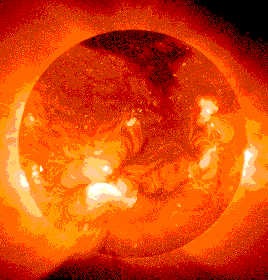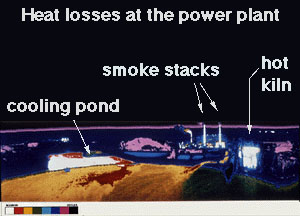This is an image of the Sun.
Click on image for full size
Lockheed Palo Alto Research Laboratory
At almost the same time, the Sun condensed to the point of initiation of hydrogen fusion. This means that the Sun "turned on" and began to shine and radiate intense energy to space. This event coincides with a brief period in stellar evolution called the T-Tauri phase. In the T-Tauri phase, the newly energized star blows the outermost portions of its atmosphere forcefully away into space sort of like a bubble which bursts and splatters material into the immediate area. The process continues on a smaller scale today in the form of the "solar wind"; a steady stream of stellar particles which billows past the Earth and the other planets. The magnetospheres of most of the planets protects the planets from the effects of these very energetic (and therefore dangerous) particles.
At this period of time the Sun was not very bright, however. The property of the Sun which is a measure of the intensity of light which comes from it, called the "Luminoscity" of the Sun was about 30% of what it is today.
But the force of T-Tauri "wind" was probably enough to strip Mercury, Venus, Earth, and Mars of whatever atmosphere had been gathered from the solar nebula. On the other hand, because of their larger size and greater ability to bind an atmosphere with the force of gravity, this wind did not have enough force to remove the atmospheres from Jupiter, Saturn, Uranus, and Neptune.
This is page 24 of 60












